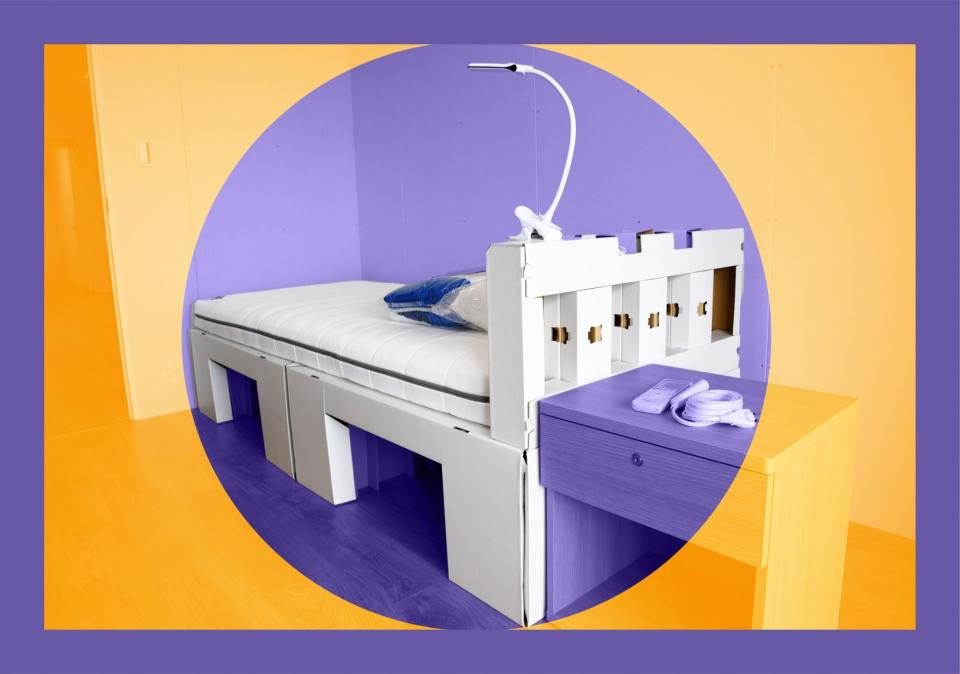What's the Deal with the 'Anti-Sex' Beds In the Olympic Village?
As athletes from all over the world arrive in Tokyo for the highly-anticipated Summer Olympics, it's clear that this year's events will be different than any other. This is, of course, thanks to the COVID-19 pandemic, which delayed the Games by a full year. In order to keep athletes and all other attendees as safe as possible, there have been plenty of safety measures put in place, with one curious creation — cardboard "anti-sex" beds — going viral on social media.

Akio Kon/Bloomberg via Getty Images
Ahead of the Games, which begin on July 23, athletes and social media users alike have shared photos of the beds in the Olympic Village, aka the spaces where athletes stay before and during the Games. Though the Village is reportedly known for being a raucous party atmosphere for young athletes, organizers are trying to minimize close contact between athletes as much as possible this year — and that, some social media users speculate, is the true reason behind the odd-looking beds.
What exactly is an "anti-sex" bed, you might ask? Based on photos shared by the athletes themselves, it's a bed made of cardboard, designed to "withstand the weight of a single person to avoid situations beyond sports," according to U.S. track and field athlete Paul Chelimo, who recently shared photos of the single-person beds on Twitter, where he also joked about flying business class to Tokyo only to now sleep "on a carton box."
Your next questions likely include: How the heck can a bed be made out of cardboard? And why have the athletes been given such unusual crash pads?
Apparently, no, it's not a ploy to discourage competitors from getting it on, although organizers are discouraging close contact of any kind to prevent potential COVID spread. Rather, the bed frames were designed by a Japanese company called Airweave, marking the first time Olympic beds will be made almost entirely out of recyclable, renewable materials, according to the New York Times. (Related: Coco Gauff Withdraws from Tokyo Olympics After Testing Positive for COVID-19)
In an effort to help reduce furniture waste and promote sustainability, reps for Airweave told the New York Times in a statement that the modular, eco-friendly beds are actually much sturdier than they look. "Cardboard beds are actually stronger than the one made of wood or steel," noted the company, adding the beds can safely support up to 440 pounds of weight. They can also be customized to suit the athletes' individual body types and sleep needs.(Related: How Nike Is Bringing Sustainability to the Tokyo Olympics)
"Our signature modular mattress design allows for firmness customizations at the shoulder, waist and legs to achieve proper spine alignment and sleep posture, allowing for the highest level of personalization for each athlete's unique body type," Airweave recently told design magazine Dezeen.
Further debunking the myth that the beds are designed to prevent hookups, the Tokyo 2020 Organizing Committee announced in April 2016 that it had partnered with Airweave for the Olympic Games, long before COVID-19 was declared a global pandemic. Airweave had been tasked to supply 18,000 beds for the Summer Games, according to Reuters in January 2020, with 8,000 beds set to be repurposed for the Paralympic Games, which will also take place in Tokyo in August 2021.
Irish gymnast Rhys McClenaghan even took to social media to help squash the "anti-sex" rumors, jumping up and down on the bed and declaring that the hubbub is nothing more than "fake news." The Olympic athlete shared a video of himself on Saturday testing the bed's strength, dispelling the reports that the beds are "meant to break at any sudden movements." (And, just saying: Even if the beds were designed for this purpose, where there's a will, there's a way. You don't need a bed when you have a chair, open shower, or standing room. 😉)
“Anti-sex” beds at the Olympics pic.twitter.com/2jnFm6mKcB
— Rhys Mcclenaghan (@McClenaghanRhys) July 18, 2021
Along with being safe enough to support the weight of each athlete as they get their much-deserved rest, the bed frames will be recycled into paper products and the mattress components into new plastic products after the Games, according to Olympic organizers. Though officials are still hoping to prevent the spread of COVID-19 by limiting condom distribution and banning sales of alcohol on site, it seems the "anti-sex" bed controversy is much ado about nothing.

